Crown formation is a significant process in growing a fruit tree. The purpose of agrotechnical reception with the help of the developed algorithm is to achieve optimal regulation of the growth and fruiting of the apple tree. Pruning - a strong effect on a living organism. and it should be carried out only taking into account the structure and laws of the life cycle of the tree.
Table of contents
Advantages of a formed crown
An apple tree that has not undergone formation, bears fruit well and develops only in the first years. After a few years, crown thickening occurs. Without receiving sunlight, the central leaves take carbohydrates from those located on the periphery. This leads to a general weakening of the tree and the death of weaker branches. On dead wood and condensed crown creates a favorable environment for the formation of fungi.
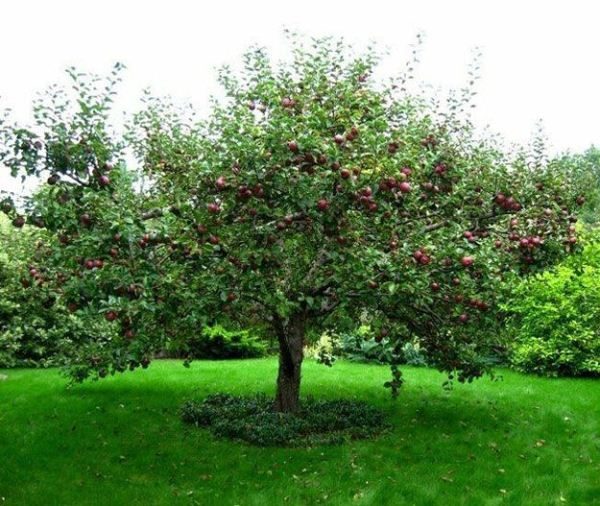
The lateral branches of the tree begin to grow at an acute angle, and strongly compete with the central shoot. As a result, the apple tree can reach up to 8 meters in height. This is the cause of frequent breakage of the branches under the weight of fruits and precipitation, greatly complicates the harvest.
During the formation of the fruit, the distribution of minerals and water is uneven.. Apples do not get the necessary products of photosynthesis, are deformed and shallow. Ensuring a steady supply of nutrients to all organs of the apple is the basis for the regulation of growth and fruiting.
The main objectives of the formation of the crown:
- providing sunlight each section of the tree;
- uniform flow of mineralin and water on all the branches;
- tree resistance to high crop loads and adverse weather conditions;
- prophylaxis the appearance of pests and diseases;
- boost fruit quality;
- age extension fruiting;
- labor productivity increase when harvesting.
Season selection
The most productive and successful period for pruning apples spring months - March and April. The process needs to be organized before the kidney swelling phase, so the tree will only spend all its energy on regeneration and will quickly recover.. To do this, choose a day with a dry weather with air temperatures above 0 ° C.
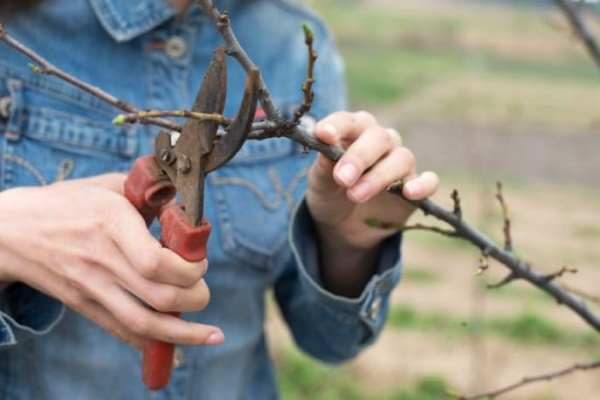
The absence of leaves makes it possible to quickly assess the condition of the crown and determine the correct degree of pruning. The formation of the crown before the growing season contributes to the active development of the tree in the summer.
The main objectives of the autumn pruning - preparation of the tree for the winter and the final formation of the crown.To do this, select September or October. Removed, formed during the summer unwanted shoots, old and rotten branches. Cut massive branches, which under the weight of snow can break.
Autumn pruning of apple trees is recommended to be done only in regions with a temperate climate. In the northern regions, characterized by a sudden decrease in temperature, the tree may not have time to recover and freeze. This leads to the drying of the tissues of the apple and its subsequent death.
In some cases, auxiliary pruning may be needed, which is done in summer.. At this time, pinch overgrown shoots and get rid of the branches that interfere with the penetration of light to the central leaves.
Preparation for the formation of apple crown
Before starting work, you need to prepare the tools. This is a pruner for trimming thin branches and a garden file for thick boughs. It is important that the tools are well sharpened. This is necessary primarily for the health of the tree. The rate of overgrowing of wounds depends on the accuracy and accuracy of cuts.
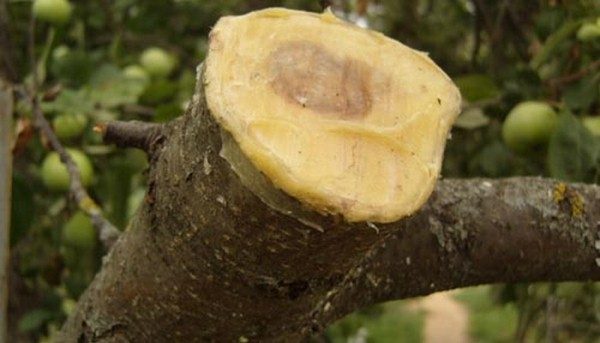
For slices with a diameter of more than 1.5 cm, additional protection is required. For their processing used garden var. The cut surface is covered with a thin layer of the prepared means. Too dense layer will lead to subsequent runoff of the vara and blockage of the stomata of the bark, which will disrupt the air exchange in the tissues of the tree.
All work on the formation of apple crown should be carried out only with minimal disruption of the physiology of the tree. Cuts with shears are made from bottom to top, the lower blade should be located on the surface of the annular inrush.
The proper development of the fruit tree depends on the initial actions after the purchase of the seedling. It is important to pay attention to the ratio of the root system and the height of the sapling.
When digging a seedling in the nursery or in the adjacent garden, only part of the roots is extracted,about 30-35 cm. Such a volume cannot provide power for the above-ground part, designed for meter roots. Therefore, the seedling should be shortened by 30 cm, otherwise the tree will be very sore. This procedure contributes to the formation of strong lateral shoots in the first year.
In branched saplings removed all shoots up to 50 cm from the ground level. This is how the stem is formed - the section of the trunk from the root collar to the first branches. Above it departs from the central escape (conductor) and the branches growing from it at an acute angle, are completely removed. The remaining shoots are shortened to the third or fifth bud. Of them in the future will form the main branches of the tree, called skeletal.
The main form of the crown of the tree
In gardening, several apple crown formation patterns are practiced.. When choosing a particular form, they are guided by the characteristics of the structure of the tree and the density of plantings in the garden.
Long-sparse form
A fairly simple and most commonly used method of forming apple crown. The pruning scheme allows you to preserve the natural appearance of the fruit tree.
The number of main branches depends on the density of plantings and the power of apple growth.If between fruit trees the distance is within 4 m, 4-5 branches are left, with more spacious plantings from 5 to 7. An increased number of skeletal branches is also necessary for strong-growing trees with spreading crowns.
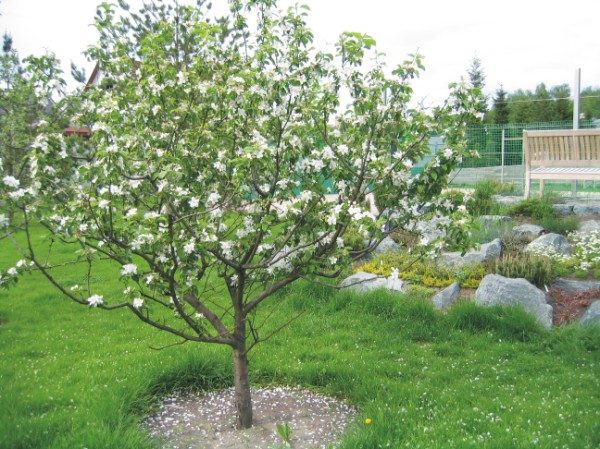
Stages of crown formation:
- At the trunk level, one main branch is left.. All increments that appeared last year at a height of 50 cm are removed.
- Choose two more branches, each of which is located 15 cm above. It is important that they are directed in opposite directions with a divergence angle of 120 °.
- The branches, which are located near the point of growth of the central conductor at an acute angle, are cut off. Lateral branches are cut at the same level.
- Next summer two more main branches are laidlocated higher by 50-60 cm with an interval of 10-15 cm. They also equalize
- Must cut competing shoots. The conductor must always be higher than the end of the lateral branches by 15-20 cm and no more. This indicator should be followed throughout the life of an apple tree.
- Entirely cut branches that are not included in the core. They can also be temporarily bent to a horizontal position.This method helps to accelerate fruiting.
- Next year need lay another branch 40 cm higher. So ends the formation of the skeleton of the crown.
In a year or two, when the branch from the last tier acquires stability, the central conductor is cut off above it. Further growth of the tree is undesirable, it is necessary to keep the height at the level of 2.5-3 m.
Spindle shape
This form of crown is recommended for low-growing and semi-dwarf varieties of fruit trees. Apple tree with a spindle-shaped crown - a tree with a cone shape, the horizontal nature of the branches of which is achieved by tying during shaping to a supporting stake. The length of the support should be 2.5-3 m.
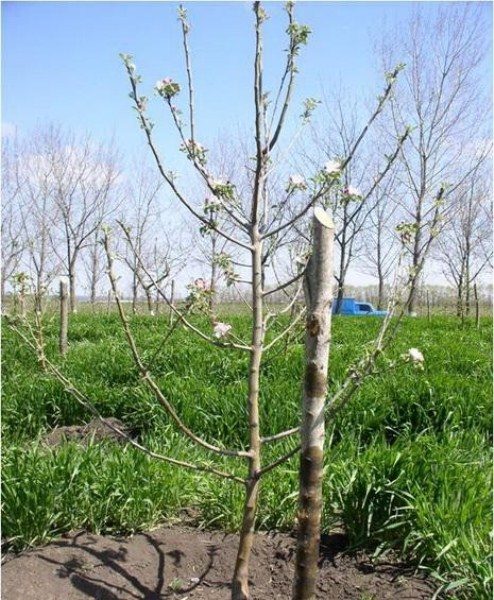
Stages of crown formation:
- In the first year 3-4 strong branches are selected at a height of 60 cm. They are cut in half, on the kidney facing outwards. The remaining branches are deleted. The central conductor should be longer than the upper lateral branch by 3 buds, the rest of the section is cut off. At the end of August, the side branches should be pulled back to an angle of 60 ° and tied with a soft thread.
- In the second year 1/3 of last year's growth is cut off from the central conductor. Skeletal branches are cut 1/4 of the kidney facing down. Last year's rope bundles are removed, and at the end of the summer new lateral branches are being delayed. Lateral growths are removed.
- Next summer the process is repeated. The conductor is cut to 1/4. The branches of the upper tiers should always be shorter than the lower ones by 10-15 cm. The bending of the branches is stopped when they take the required angle or the tree begins to bear fruit.
When the apple tree grows to 2-2.5 m, prune the conductor to the side branch, which is tied to a pole. In the future, it forms the central conductor.
Cup shape
This type of crown is formed according to the principle of longline-sparse and is used for low-growing apple trees. The fundamental difference is the absence of a central conductor.
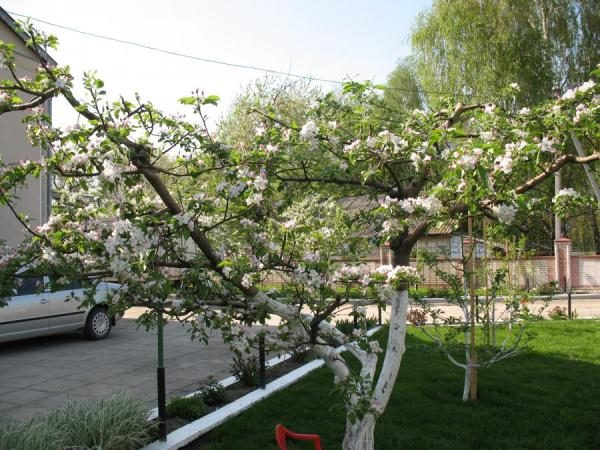
A 50 cm high stem and another 30 cm are left on the seedling to form skeletal branches. The rest is clipped. In the following year, 3 skeletal branches are formed above the stem according to the recommended scheme. The conductor is cut off at the level of the upper side branch. As the branches of the second and third order are formed, all the branches directed to the crown center are cut.
Vertical palmette
Apple trees, formed by the type of vertical palmettes, are grown near the fences. This type of crown makes it possible to cultivate an apple tree in limited areas or to use as a decor. in hedges.
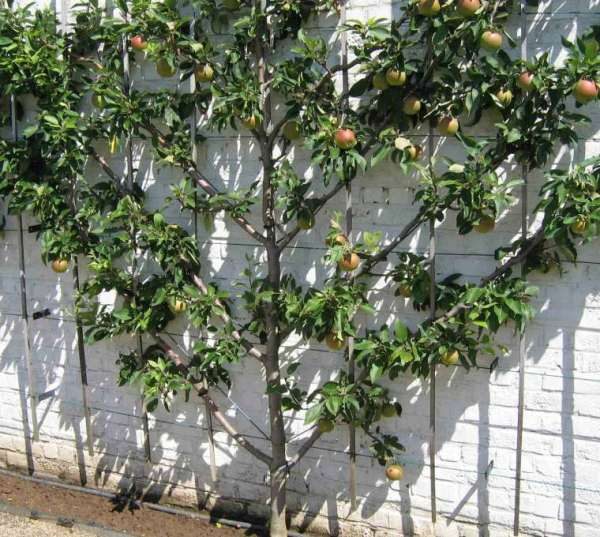
Stages of crown formation:
- Planting of one-year sapling without branches. Along the seedling need to drive a pole and tighten the horizontal wire. The three upper buds are selected, the lower of which are directed in different directions. The barrel is shortened to 40-60 cm from the ground level.
- In the summer, the main shoot is formed from the upper bud and directed along the pole.. From the other remaining buds, horizontal shoots are formed. In order not to harm the growth of the tree, horizontality is achieved gradually. Therefore, in the first year, shoots are tied at an angle of 45 ° with respect to the conductor.
- In the fall, lateral branches are placed horizontally, tying them to the wire.. The extra shoots formed on the trunk are cut to the third bud.
- Spring need to trim the center conductor, leaving a plot with three buds, height 45 cm. Horizontal branches are cut to 1/3. The extra side branches are shortened, leaving only three buds.
- In summer, the second tier is formed according to the recommended scheme.. Until autumn, all competing shoots are shortened, leaving only three buds on them. In the fall, the growth of horizontal shoots is tied to a wire.
After the final formation of the crown, the center conductor is cut off. The number of tiers depends on the type of soil, location and strength of the apple tree. Experienced gardeners recommend no more than 4-5 tiers. After the final formation of the crown need to constantly cut off the shoots formed between the tiers.
Rejuvenating pruning apple
With age, the fruiting tree moves to the top of the crown. The length of annual increments is reduced to 35 cm, this affects the amount of harvest.. In this case, the apple tree needs a rejuvenating pruning.
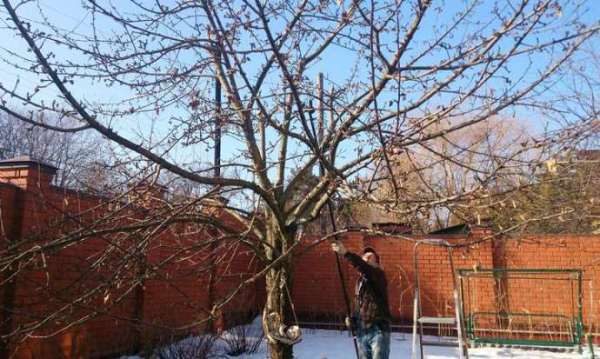
First, remove the dry and damaged branches. Cut off the branches that grow inside the crown, it will stimulate the growth of young shoots. Overgrown skeletal branches pruned to lateral branches. All branches above young branches are deleted.
The procedure for rejuvenating the apple tree is best done in two springs.. Too many wounds greatly weaken the tree. After pruning apple requires increased care: watering, fertilizing and protection from pests.
Errors during crown formation
One of the most common mistakes made when cutting an apple tree is to leave a hemp in place of the cut, from which an excessive number of shoots are formed. This leads to even more thickening of the crown.

Too short stub is also undesirable.. He will not give new shoots, but drying out will lead to the sliding of the bark and the exposure of the wood. This threatens to necrosis the site, which creates a favorable environment for diseases. Therefore, it is necessary to cut off the branch according to a circular influx, in which active sap flow is taking place and the wound will quickly heal.
Another error indicates a significant decrease in the crown of the apple tree. This happens if competing shoots grow above the center conductor. In the summer season, such branches pinch, and in the spring they are removed completely.
Insufficient thinning of branches leads to the fact that the diameter of the crown increases. A correctly developing crown has no more than 5-7 skeletal branches, without increments directed towards the trunk.
Formation of apple crown takes a lot of time only in the first 3-4 years. In subsequent seasons, you only need to control the gains and send them in the right direction. This is the only way to achieve stability and quality of the harvest, which will please more than one generation.
